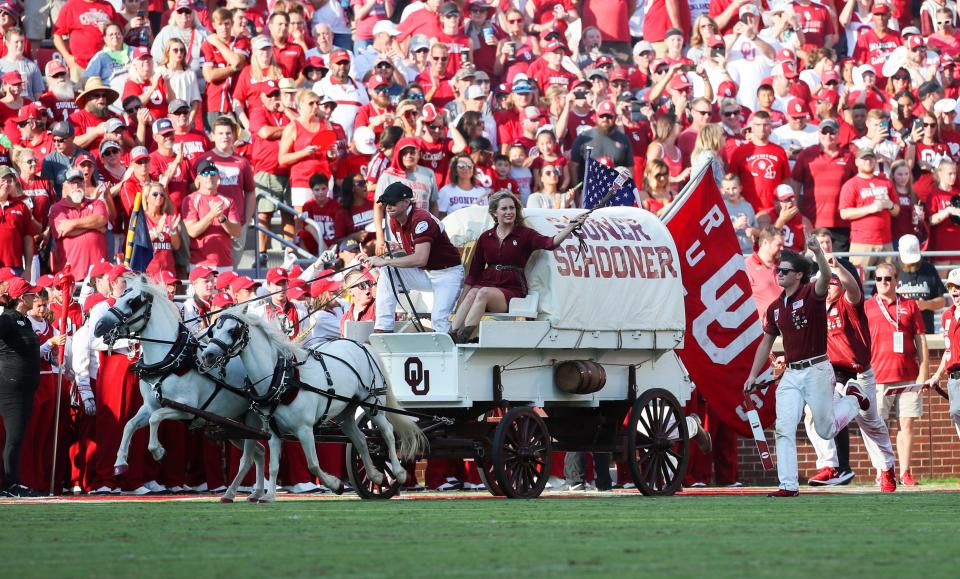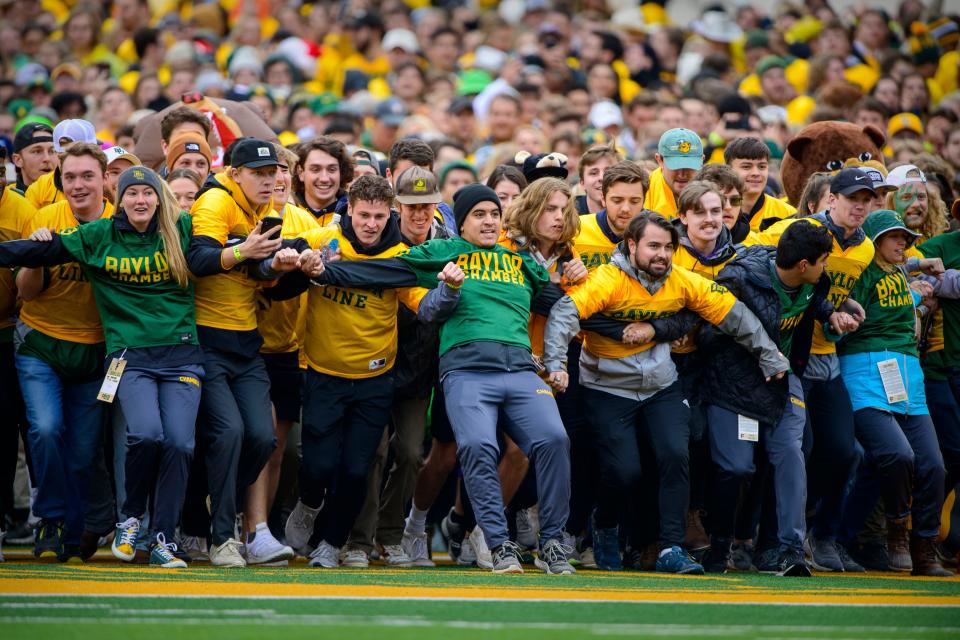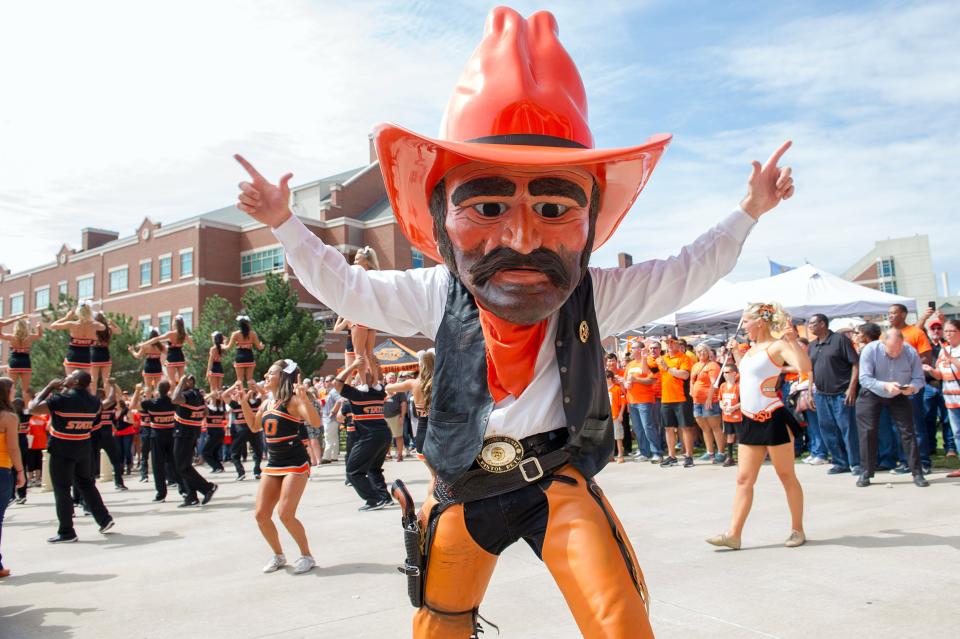Blending old and new, here are the best college football traditions in the Big 12
Traditions, by definition, are forged over time and create a legacy for those that come to celebrate them. College football, though, deals with constant change with realignment and playoff expansion.
The Big 12 is in the midst of a transition period with two of its biggest programs – Oklahoma and Texas – headed out the door for the SEC next year and four new schools – Brigham Young, Central Florida, Cincinnati and Houston – joining for this season.
Each of the 14 schools in the league for the 2023 campaign have their own unique characteristics. And among them are important traditions their fans celebrate. But not all are created equal. Here is our tiered ranking of the conference's traditions from top to bottom with the old guard and new faces both being included in each group.
SPORTS NEWSLETTER: Sign up to get the latest news and features sent directly to your inbox
Tier One - The best of the best
Oklahoma
The Sooner Schooner — The replica of the Studebaker Conestoga wagon that is the symbol of the University of Oklahoma is one of the best-known images in college sports. Powered by two ponies – Boomer and Sooner – the wagon first appeared at a football game in 1964. It rides on the field after scores, taking a circuitous route from one of the tunnels and back. Most of the time, the celebration goes swimmingly, but there have been a couple of instances where it has broken down and also famously drew a penalty for riding on the field too early in the Orange Bowl in 1985.

Texas
The Eyes of Texas — The lyrics to the school's famous fight song were written by John Sinclair in 1903 to mock then-school president William Lambdin Prather, who often referenced the eyes of Texas being on students as a way to encourage them to have future success. Meshed to the popular melody of "I've Been Working on the Railroad," the song soon became a mantra for all Longhorns fans and is sung after every game, with fans in the stands and players both holding up the famous "Hook 'em Horns" hand gesture. The song has been a source of controversy due to Prather's connection to Robert E. Lee, who is thought to have referenced "The eyes of the South are upon you" as an advocation of the Confederacy's position on slavery after the Civil War, as well as the song debuting at a minstrel show where performers were likely in blackface.
BEST COLLEGE FOOTBALL TRADITIONS: SEC | Big Ten | Big 12 | ACC | Pac-12
Brigham Young
Y Mountain — BYU president George H. Brimhall commissioned the painting of the school's initials on a mountain overlooking the campus in 1906. The first letter was the "Y" so that they other two would be properly centered when they were later added. However, the process – expected to be finished that day – went slowly with paint having to be dragged up the mountain. By 4 p.m., only the "Y" was completed, and it was decided that the other two letters wouldn't be completed. The "Y" remains today on the mountain after constant upkeep and has become the symbol of the school and appears on the side of the team's football helmets.
West Virginia
Take Me Home Country Roads — This is simply a perfect match of a song that never goes out of style and a football program and state that embraces its lasting chorus. John Denver's ode to the Mountaineer State as the "place I belong" has been performed before every home game since 1972 and is also played after victories. While defeat for the road teams might taste sour, even they could appreciate the rendition with 60,000 fans at Milan Puskar Stadium singing along in such spirited fashion.
Tier Two: The middle pairings
Texas Tech
Tortilla tossing — Tortillas and the Southwest go hand in hand, so it shouldn't be totally odd that throwing the flour-based circular Mexican food like frisbees at football games is considered fun. What's unclear is how the tradition started. The leading version is that before the Red Raiders played Texas A&M in 1992 an ESPN announcer quipped Lubbock had "nothing but Texas Tech football and a tortilla factory." So how did fans respond? They brought tortillas and tossed them at kickoff. A different version dates to 1989 when drinks stopped being served with lids at the stadium because fans were throwing them on the field. As a response, tortillas were brought and tossed, and the practice has continued. Whatever the genesis of the story, it's one thing that is unique to Texas Tech.
Kansas State
Wabash Cannonball — The origin of the favored fight song of Wildcats fans dates back to 1968 and a fire at the music department in Nichols Hall believed to have been started in protest of the Vietnam War. Among the items lost were radio station equipment, sheet music and instruments. The one item that survived was the music sheet for the song "The Wabash Cannonball." The director of the marching band had brought that sheet music home and subsequently that was the only song played at a home basketball game after the blaze. The song is now played to inspire school spirt and it incites fans at football games to clap and dance along.
For subscribers: Which Big 12 football matchup ranks No. 1 among new-look conference's 105 games in 2023?
Baylor
The Baylor Line — Some of the best seats at Baylor football games go to the freshmen. But how they get there isn't so simple. Created in 1970, the Baylor Line is the tradition of first-year students taking the field donning gold jerseys they were awarded in the summer prior to the start of classes. They gather at the south end of McLane Stadium and sprint on to the field with the football team before taking their seats in the stands before kickoff. It's quite the spectacle that can inspire spills among runners but a lot of laughs in the chaos.

TCU
Riff, Ram, Bah, Zoo — Considered one of the oldest chant in college football, the Riff Ram got its start in the 1920s when the Horned Frogs were emerging as one of the powerhouse programs for the pre-World War II era. The words don't mean anything, but it does engender tremendous enthusiasm from TCU fans prior to the game as they dance and repeat the phasing with increased pace. To further raise the intensity, former players, including LaDainian Tomlinson and Andy Dalton, have been brought back to lead the cheer.
Central Florida
The stadium formerly known as the Bounce House — UCF only started playing football in 1979 at the Division II level before making a move to the Championship Subdivision in 1990 and later the Bowl Subdivision in 1996. Its current playing facility opened in 2007 with the naming rights sold to Bright House Networks and soon earned its Bounce House moniker due to the shaking in the stands when the crowd jumped in union. The phenomenon now notably occurs while "Kernkraft 400" by Zombie Nation is played. The Bright House sponsorship ended in 2019, and, with the rights in limbo, the stadium officially was known as the Bounce House until FRG Mortgage took over in 2022. The legacy still remains.
Oklahoma State
Pistol Pete — This year marks the 100th anniversary of the creation of the esteemed mascot used by the school, which previously had adopted a tiger and the black and orange colors of Princeton. The inspiration for the cowboy caricature dates back to Frank Eaton, who was riding a horse as part of an Armistice Day Parade in 1923. He became the likeness used to create Pistol Pete. The school would officially embrace the mascot in 1958 as a reminder of the Old West. Usually 10 to 15 students try out for the honor of being selected to wear the costume, and two are chosen to represent the numerous appearances required throughout the community.

Tier Three: The bottom rung
Houston
Shasta — Without a mascot at the school when he arrived to coach football in 1927, John W. Bender suggested a cougar – the same one used at Washington State, where he also coached. The cougar was approved, however, it had no nickname until in 1947 when the Alpha Phi Omega fraternity on campus raised funds to buy a live cougar and had a naming contest. Shasta was selected ahead of more than 200 suggestions. A live cougar served as the school's mascot until 1989 when Shasta V died. After 23 years, the school and the Houston Zoo former a partnership where the zoo would house a live mascot that didn't appear at school events. That mascot, Shasta VI, passed away in 2022 and two orphaned cubs from the state of Washington recently were brought to the zoo as successors.
Iowa State
Victory Bell — A bell has played a significant role on the Ames campus for more than 100 years. The first one installed in 1868 and used to announce changes to class periods and the start of student curfews before being damaged in 1890. A new bell was cast by Clinton H. Meneely Bell Co. of Troy, New York, that same year. The bell came to be obsolete for its original intent but was adopted by the football program early after the turn of the century and is now rung after every home football victory.
Kansas
Biding time before basketball starts — It is fair to say that interest in the football program mostly constituted a diversion in the early fall to what was really important – the beginning of men's basketball practice. That changed somewhat in the first half of 2022 when the Jayhawks opened 5-0 and ESPN's GameDay visited before a showdown with TCU. And if you're wondering, yes the do chant Rock Chalk Jayhawk at football games, so points for that tradition, too.
Cincinnati
The Cat Walk — No, the football players don't stroll down a runway before games as a super models would. Instead, the marching band and team gather on campus about 2 ½ hours before home games and walk toward the stadium with the band playing "Cheer Cincinnati." Fans gather along the route to celebrate the festivities before filing into the stadium after the team and band have arrived.
This article originally appeared on USA TODAY: Big 12 college football traditions start with Oklahoma, Texas, BYU

